The Battle of Antietam was fought on 17th September 1862 near Antietam Creek in Sharpsburg, Maryland. Also known as the Battle of Sharpsburg, it was the first major battle of the American Civil War to be fought on Union soil. Battle of Antietam is considered to be a victory for the Union forces led by General George B. McClellan against the Confederate Army of General Robert E. Lee. The battle remains infamous for being the bloodiest single day in American military history. Know about the causes, events, casualties, effects, impact and significance of this historic battle that changed the course of the Civil War.
#1 IT WAS PART OF THE MARYLAND CAMPAIGN LED BY ROBERT E. LEE
Following his victory in the Northern Virginia Campaign, Southern General Robert E. Lee decided to move the war northward for several reasons including – need for military and other supplies; cutting off Baltimore & Ohio Railroad line that supplied Washington by capturing Northern states of Maryland and Pennsylvania; and to dent the Northern morale by threatening Washington in a bid to make their population and government unwilling to continue the war. This led to the Maryland Campaign, which was the first invasion of the North by the Southern Confederate Army.
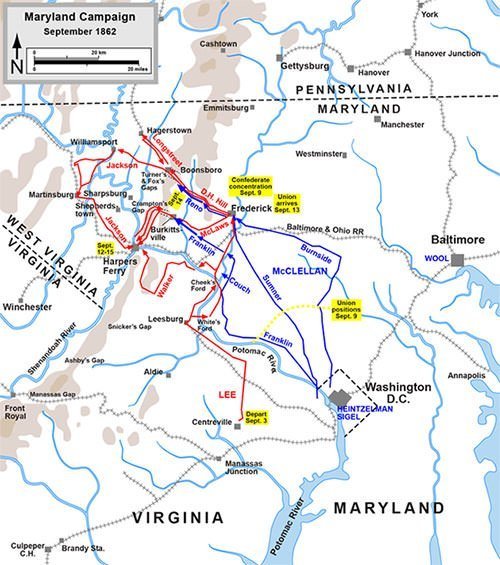
#2 THE UNION TROOPS WERE COMMANDED BY GEORGE B. MCCLELLAN
On 2nd September 1862, President Abraham Lincoln appointed Major General George B. McClellan to command the Union forces against Lee’s invasion. Lee’s Army of Northern Virginia of around 55,000 men entered Maryland on 3rd September 1862. Lee adopted the risky strategy of dividing his army to seize the Federal garrison and arsenal at Harpers Ferry, simultaneous to his march northwards. A lost copy of the details of the movement of Lee’s army (Special Order 191), including the fact that it was divided, was discovered by two Union soldiers. However McClellan waited too long and failed to take advantage of this intelligence, squandering an opportunity to defeat Lee decisively.
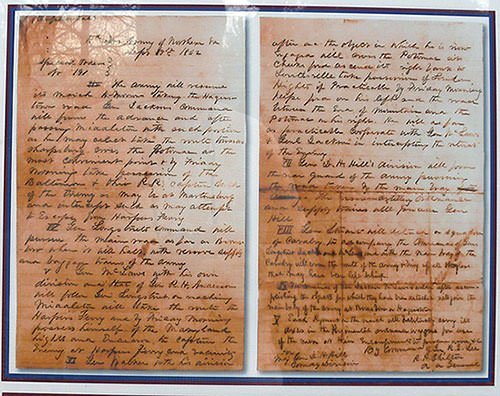
#3 IT WAS PRECEDED BY BATTLES AT HARPERS FERRY AND SOUTH MOUNTAIN
Two significant military engagements prior to the Battle of Antietam were the Battle of Harpers Ferry, during which a portion of the Confederate Army under General Stonewall Jackson captured the Union garrison at Harpers Ferry; and the Battle of South Mountain, which involved three pitched battles McClellan’s Army of the Potomac had to fight to pass through Blue Ridge Mountains to meet Lee’s forces. Stout Confederate defenses during the latter battle delayed McClellan’s advance long enough for Lee’s army to reunite.
#4 BATTLE OF ANTIETAM STARTED AT DAWN ON 17TH SEPTEMBER 1862
The Battle of Antietam started at dawn (around 5:30 a.m.) on 17th September 1862 with Union corps led by Major General Joseph Hooker mounting the first of three major assaults on Robert Lee’s Confederate army. This powerful assault on Lee’s left flank saw repeated Union attacks and Confederate counterattacks mainly across farmer David Miller’s thirty-acre cornfield (Miller cornfield) and the West Woods. The assault, which lasted for four hours, remained indecisive.

#5 AN AREA OF ITS BATTLEFIELD IS NOW KNOWN AS BLOODY LANE
The second major Union assault was towards Lee’s center. For nearly four hours, from 9:30 a.m. to 1 p.m., bitter fighting raged along what was then known as Sunken Road. After a terrible struggle, Union forces were successfully in driving Confederate forces from a strong defensive position and piercing their center. However the assault was not followed by further advances leading to loss of this temporary advantage for McClellan’s Army of the Potomac. Due to the large number of casualties (about 5,600) that occurred at Sunken Road, it later became known as Bloody Lane.
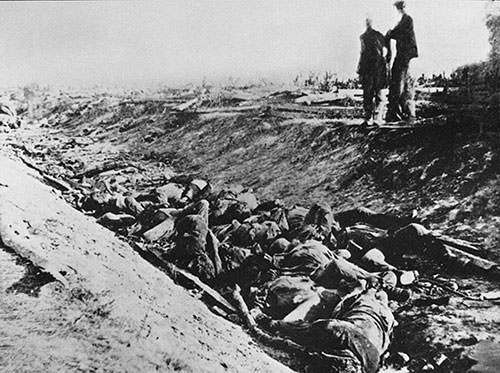
#6 THE THIRD MAJOR UNION ATTACK WAS LED BY AMBROSE BURNSIDE
The last major action of the battle was an assault against Lee’s right late in the day. Union forces led by Major General Ambrose Burnside pushed across a stone bridge over Antietam Creek amid Confederate sharpshooters on high ground. With some difficulty Burnside’s corps managed to imperil Lee’s right but were stopped by late-arriving Confederate reinforcements. The bridge over which this part of the battle was fought is now known as Burnside’s Bridge after the Union General.
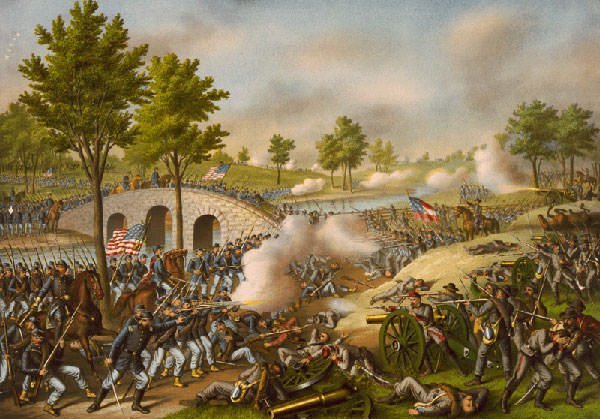
#7 It IS THE BLOODIEST SINGLE DAY IN AMERICAN MILITARY HISTORY
The next day, September 18, Robert Lee’s army withdrew back across the Potomac to Virginia, ending his first invasion into the North. The Union had 12,401 casualties with 2,108 dead while Confederate casualties were 10,318 with 1,546 dead. 1,910 Union and 1,550 Confederate troops died of their wounds soon after the battle and 225 Union and 306 Confederate troops listed as missing were later confirmed as dead. The Battle of Antietam therefore killed 7,650 American soldiers. More Americans died at the battle than on any other day in American military history.
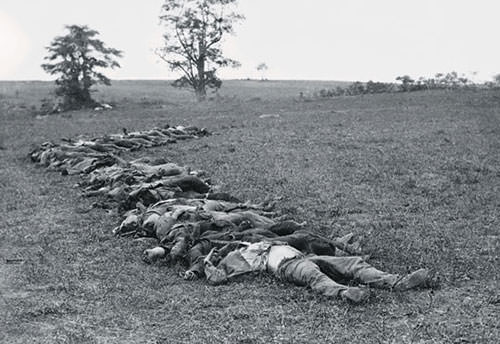
#8 BATTLE OF ANTIETAM IS CONSIDERED A VICTORY FOR THE UNION FORCES
Historians generally believe that McClellan performed poorly at the battle making several strategic errors and failing to press home the advantage amid several opportunities while Robert E. Lee displayed great leadership in holding his own against an army that greatly outnumbered his. Still the Battle of Antietam is considered a victory for the Union as Lee withdrew from the battlefield first and McClellan was able to halt Lee’s invasion of Maryland.
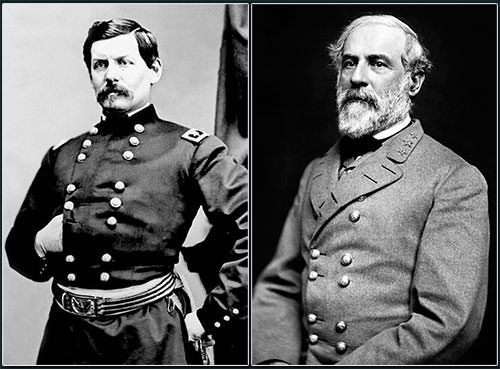
#9 IT WAS FOLLOWED BY The EMANCIPATION PROCLAMATION
President Abraham Lincoln used the occasion of the Antietam victory to issue the famous Emancipation Proclamation on September 22, 1862. It came into effect on January 1, 1863 and changed the federal legal status of more than 3 million enslaved African Americans in the South from slave to free. Lincoln’s proclamation was influential in dissuading France and U.K. from recognizing the Confederacy as the public there wouldn’t have tolerated their governments assisting a state supporting slavery.
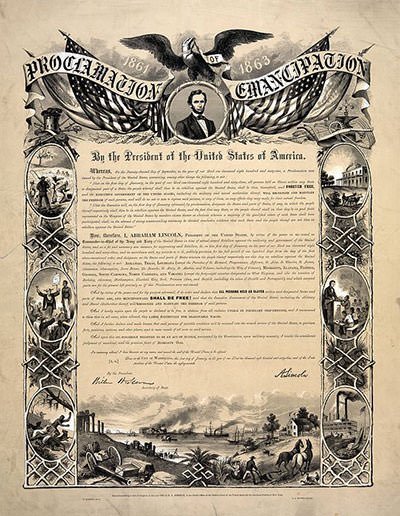
#10 IT IS CONSIDERED A TURNING POINT IN THE AMERICAN CIVIL WAR
Battle of Antietam was the first major battle of the American Civil War to be fought on Union soil. It was among the most important military operations of the entire Civil War and is considered by many historians as the turning point of the war as it ended the threatening Maryland Campaign of Robert Lee and gave Lincoln an ideal opportunity to issue the Emancipation Proclamation. The battle remains among the most well-known American battles and the Antietam National Battlefield, a National Park Service protected area, is visited by over 330,000 people each year.
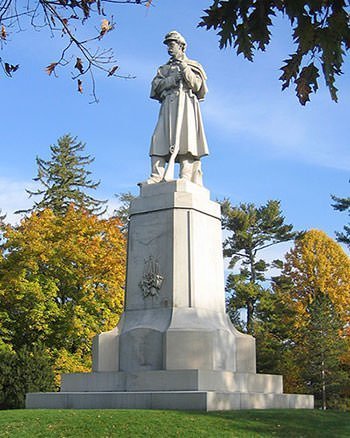
THE DEAD OF ANTIETAM
Mathew Brady was an American photographer who is considered the father of photojournalism. Two days after the Battle of Antietam, Brady sent photographer Alexander Gardner and his assistant James Gibson to photograph the carnage. These photos were displayed in October 1862 at an exhibition entitled “The Dead of Antietam” at Brady’s New York gallery. This was the first time that many Americans saw the realities of war in photographs as distinct from previous “artists’ impressions”.


Hey there! Someone in my Facebook group shared this website with
us so I came to look it over. I’m definitely loving the information. I’m
book-marking and will be tweeting this to my followers! Outstanding blog and terrific style and design.